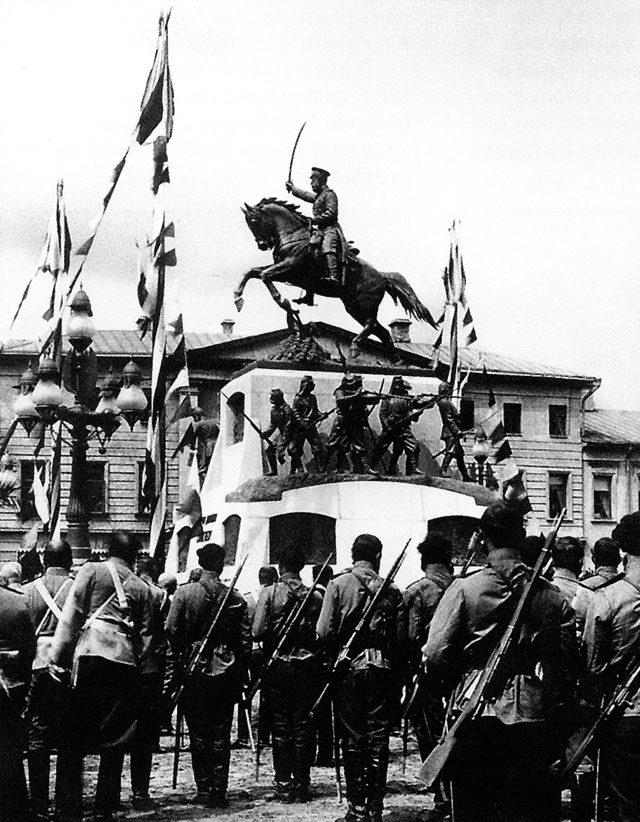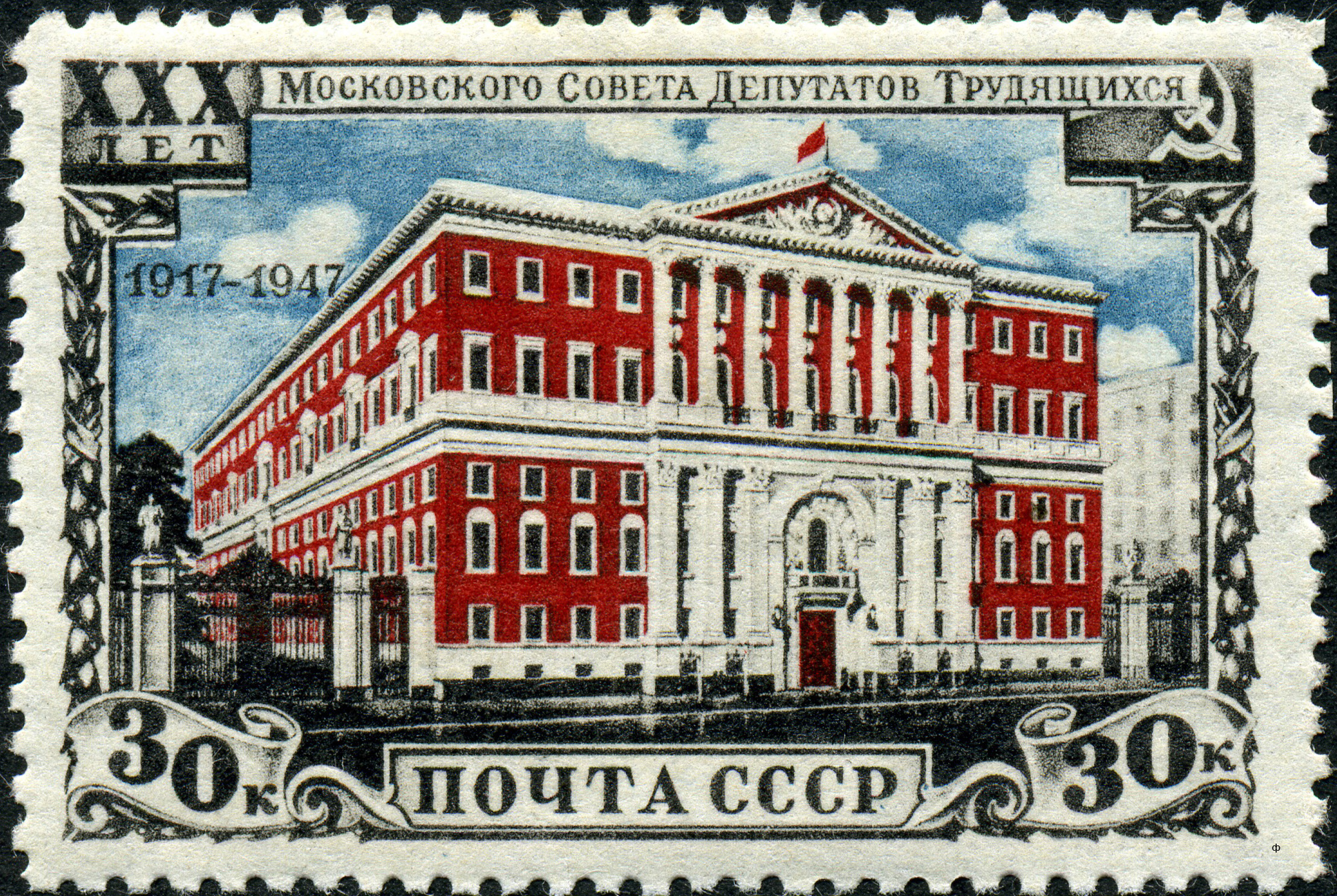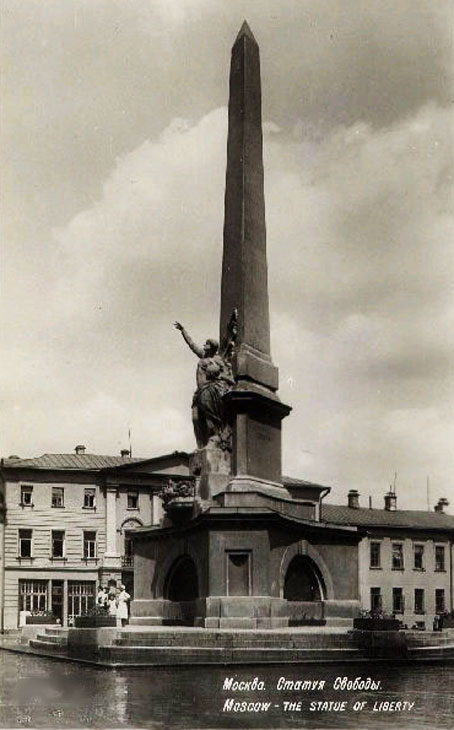Statue of Yuriy Dolgorukiy, Moscow on:
[Wikipedia]
[Google]
[Amazon]
The Statue of Yuriy Dolgorukiy is an



 The original statue erected in 1912 in Tverskaya Square was of General
The original statue erected in 1912 in Tverskaya Square was of General
Прогулки по Москве >> Памятник Юрию Долгорукому
/ref> At the unveiling of the statue, the writer, said, "It is not a good likeness". However the composer, Sigizmund Abramovich Kats disagreed, and said, "It is a good likeness".Author: Алексей Митрофанов. Title: Прогулки по старой Москве. Тверская. Publisher: Ключ-С, Moscow. Date 2006.
equestrian statue
An equestrian statue is a statue of a rider mounted on a horse, from the Latin ''eques'', meaning 'knight', deriving from ''equus'', meaning 'horse'. A statue of a riderless horse is strictly an equine statue. A full-sized equestrian statue is a d ...
which commemorates the founding of Moscow
Moscow ( , US chiefly ; rus, links=no, Москва, r=Moskva, p=mɐskˈva, a=Москва.ogg) is the capital and largest city of Russia. The city stands on the Moskva River in Central Russia, with a population estimated at 13.0 million ...
in 1147 by Yuriy Dolgorukiy
Yuri I Vladimirovich ( rus, Юрий Владимирович, Yuriy Vladimirovich), commonly known as Yuri Dolgorukiy or the Long Arm ( rus, Юрий Долгорукий, Yuriy Dolgorukiy, meaning "Far-Reaching", c. 109915 May 1157) was a Rur ...
(1099 1157). Dolgorukiy was the Grand Prince
Grand prince or great prince (feminine: grand princess or great princess) ( la, magnus princeps; Greek: ''megas archon''; russian: великий князь, velikiy knyaz) is a title of nobility ranked in honour below emperor, equal of king or ...
(''Velikiy Knyaz'') of the Kievan Rus'
Kievan Rusʹ, also known as Kyivan Rusʹ ( orv, , Rusĭ, or , , ; Old Norse: ''Garðaríki''), was a state in Eastern and Northern Europe from the late 9th to the mid-13th century.John Channon & Robert Hudson, ''Penguin Historical Atlas of ...
(Kiev
Kyiv, also spelled Kiev, is the capital and most populous city of Ukraine. It is in north-central Ukraine along the Dnieper, Dnieper River. As of 1 January 2021, its population was 2,962,180, making Kyiv the List of European cities by populat ...
) and a member of the Rurik dynasty
The Rurik dynasty ( be, Ру́рыкавічы, Rúrykavichy; russian: Рю́риковичи, Ryúrikovichi, ; uk, Рю́риковичі, Riúrykovychi, ; literally "sons/scions of Rurik"), also known as the Rurikid dynasty or Rurikids, was ...
. On 6 June 1954, the statue was erected on Soviet Square (now ), located in front of the Mossoviet
The Mossoviet (Russian: Моссовет), an abbreviation of Moscow Soviet, (Московский Совет) was established following the February Revolution . Initially it was a parallel, shadow city administration of Moscow, Russia run by le ...
building (now the building of the Mayor of Moscow
The Mayor of Moscow (russian: Мэр Москвы, Mer Moskvy) is the head and the highest-ranking official of Moscow, who leads the Government of Moscow, the main executive body of the city.
Moscow is both a city and separate federal subje ...
). The sculptors were Sergei Mikhailovich Orlov, A. P. Antropov, and Nicholay Lvovich Shtamm. The architectural design was by . The statue replaced the , which had been demolished in 1941.
Skobelev statue



 The original statue erected in 1912 in Tverskaya Square was of General
The original statue erected in 1912 in Tverskaya Square was of General Mikhail Skobelev
Mikhail Dmitriyevich Skobelev (russian: Михаил Дмитриевич Скобелев; 29 September 1843 – 7 July 1882), a Russian Empire, Russian general, became famous for his conquest of Central Asia and for his heroism during the Russo ...
, a hero of the Russian-Turkish War
The Russo-Turkish wars (or Ottoman–Russian wars) were a series of twelve wars fought between the Russian Empire and the Ottoman Empire between the 16th and 20th centuries. It was one of the longest series of military conflicts in European histor ...
of 1877. The depicted him mounted on his horse. The monument was known as "The White General". Skobelev wore a white parade tunic and rode a white horse into battle. He was also a member of the Tsar's military force and therefore a "White
White is the lightest color and is achromatic (having no hue). It is the color of objects such as snow, chalk, and milk, and is the opposite of black. White objects fully reflect and scatter all the visible wavelengths of light. White on ...
".
Following the October Revolution
The October Revolution,. officially known as the Great October Socialist Revolution. in the Soviet Union, also known as the Bolshevik Revolution, was a revolution in Russia led by the Bolshevik Party of Vladimir Lenin that was a key moment ...
of 1917, a decree concerning monuments "erected in honour of tsars and their servants" was issued. It was part of Lenin's campaign of propaganda through monuments. Because of this decree, the Skobelev monument was removed.
Constitution obelisk
In 1918, the Skobelev monument was replaced by the .Title: Всегда и во всём быть художником. Publisher: Мир истории. Published in January, 2002. Accessdate: 2009-02-08. Language: Russian. The high, three-edged obelisk built in honour of the Soviet constitution, was erected in front of theMossovet
The Mossoviet (Russian: Моссовет), an abbreviation of Moscow Soviet, (Московский Совет) was established following the February Revolution . Initially it was a parallel, shadow city administration of Moscow, Russia run by lef ...
.
In June 1919, the obelisk was joined by a statue of liberty. It was created by the sculptor, Nikolay Andreyevich Andreyev. Vera Alekseyeva, the niece of Konstantin Stanislavski
Konstantin Sergeyevich Stanislavski ( Alekseyev; russian: Константин Сергеевич Станиславский, p=kənstɐnʲˈtʲin sʲɪrˈgʲejɪvʲɪtɕ stənʲɪˈslafskʲɪj; 7 August 1938) was a seminal Russian Soviet Fe ...
, might have posed for this statue. Another possible model was the actress at МХАТ
The Moscow Art Theatre (or MAT; russian: Московский Художественный академический театр (МХАТ), ''Moskovskiy Hudojestvenny Akademicheskiy Teatr'' (МHАТ)) was a theatre company in Moscow. It was f ...
, Eugenie Khovanskaya, who was famous for her beauty. The sculptor was inspired by the dynamic forms of classical Greek statues such as Nike of Samothrace
The ''Winged Victory of Samothrace'', or the ''Nike of Samothrace'', is a votive monument originally found on the island of Samothrace, north of the Aegean Sea. It is a masterpiece of Greek sculpture from the Hellenistic era, dating from the beg ...
.
The monument did not stand for long. By the end of the 1930s, it required complete restoration. It had been hastily and cheaply made from low grade materials; the obelisk was built in brick and plastered "like granite". The statue was cast in concrete. On 22 April 1941, before it could be restored, the monument was blown up and removed. The head of the Statue of Liberty survived and was placed in the Tretyakov Gallery
The State Tretyakov Gallery (russian: Государственная Третьяковская Галерея, ''Gosudarstvennaya Tretyâkovskaya Galereya''; abbreviated ГТГ, ''GTG'') is an art gallery in Moscow, Russia, which is considered th ...
Creation of the statue
A settlement had existed at the site of Moscow at least 200 years prior to its official founding in 1147 by Yuriy Dolgorukiy. However, the 800th anniversary of Moscow celebrations in September 1947 accepted the traditional date. This first large, post-war celebration, shortly preceded the 30th anniversary celebrations of theOctober Revolution
The October Revolution,. officially known as the Great October Socialist Revolution. in the Soviet Union, also known as the Bolshevik Revolution, was a revolution in Russia led by the Bolshevik Party of Vladimir Lenin that was a key moment ...
.
In 1946, Joseph Vissarionovich Stalin
Joseph Vissarionovich Stalin (born Ioseb Besarionis dze Jughashvili; – 5 March 1953) was a Georgian revolutionary and Soviet political leader who led the Soviet Union from 1924 until his death in 1953. He held power as General Secretar ...
sent the archaeologist and anthropologist Mikhail Mikhaylovich Gerasimov
Mikhail Mikhaylovich Gerasimov (; 2 September 1907 – 21 July 1970) was a Soviet archaeologist and anthropologist who discovered the Mal'ta–Buret' culture and developed the first technique of forensic sculpture based on findings of an ...
(1907 1970) from Kiev to find remains of Yuriy Dolgoruky. This was so that a ceremonious reburial of Dolgoruky could take place during the celebrations. No remains were found at Dolgoruky's grave.
In September 1946, a competition to design the Dolgorukiy monument was held. The sculptor S.M. Orlov won the competition and was awarded the Stalin Prize Stalin Prize may refer to:
* The State Stalin Prize in science and engineering and in arts, awarded 1941 to 1954, later known as the USSR State Prize
The USSR State Prize (russian: links=no, Государственная премия СССР, ...
for his work. The Russian writer, journalist, and historian said that Stalin selected Orlov's entry from amongst the other entries because it was praised by the United States ambassador
Ambassadors of the United States are persons nominated by the president to serve as the country's diplomatic representatives to foreign nations, international organizations, and as ambassadors-at-large. Under Article II, Section 2 of the U.S. ...
W. Averell Harriman (1891 1986) during a Moscow Kremlin
The Kremlin ( rus, Московский Кремль, r=Moskovskiy Kreml', p=ˈmɐˈskofskʲɪj krʲemlʲ, t=Moscow Kremlin) is a fortified complex in the center of Moscow founded by the Rurik dynasty. It is the best known of the kremlins (R ...
reception.Author: Васькин, Александр. Title: Тверская улица в домах и лицах. Published by Центрполиграф, Moscow, date 2015. Total pages: 236.
On 6 September 1947, the groundbreaking
Groundbreaking, also known as cutting, sod-cutting, turning the first sod, or a sod-turning ceremony, is a traditional ceremony in many cultures that celebrates the first day of construction for a building or other project. Such ceremonies are o ...
ceremony for the monument took place during the celebrations. However, the monument took some time to build. Disagreements took place between the three artists. The scale of Orlov's design and technique's were questioned. His usual small sculpture techniques might not have worked on a monumental work.
Orlov also clashed with authorities. He opposed to the text on the monument dedication, reading, "To the founder of Moscow from the Soviet government". (The Soviet government
The Government of the Soviet Union ( rus, Прави́тельство СССР, p=prɐˈvʲitʲɪlʲstvə ɛs ɛs ɛs ˈɛr, r=Pravítelstvo SSSR, lang=no), formally the All-Union Government of the Union of Soviet Socialist Republics, commonly ab ...
is not mentioned on the monument.) Insufficient funding also affected the speed of work. Moscow's anniversary marked the simultaneous launches of several large-scale projects all of which required special funding. These included the building of the " Stalin skyscrapers".
A possibly apocryphal story tells of Stalin's approval of the final version of the monument. He carefully considered the model and said, "Why do you, Comrade Orlov, have Dolgorukiy sit on the mare? A stallion can accentuate the masculinity of the founder of Moscow". Changes were introduced to the project immediately.
The sculpture was produced by the "Mytishchi
Mytishchi ( rus, Мыти́щи, p=mɨˈtʲiɕːɪ) is a city and the administrative center of Mytishchinsky District in Moscow Oblast, Russia, which lies 19 km northeast of Russia's capital Moscow on the Yauza River and the Moscow–Yarosla ...
Plant in honour of the national artist E. F. Belashova". The production was supervised by the sculptor and bronze caster Gabriel Ivanovich Savinsky. It cost 5.5 million rouble
The ruble (American English) or rouble (Commonwealth English) (; rus, рубль, p=rublʲ) is the currency unit of Belarus and Russia. Historically, it was the currency of the Russian Empire and of the Soviet Union.
, currencies named ''rub ...
s paid by the city of Moscow. The grand opening of the monument took place on 6 June 1954.
Artistic characteristics
The images of the prince have not survived, therefore the authors of the sculpture have created a collective image of a Russian hero on a fighting horse, dressed in martial armor. The rider, having stopped the horse and raised in the stirrups, with an imperious gesture as if indicating the place for a new fortress. All elements of the martial attire are meticulously depicted. The round shield fixed to the left arm of the prince is decorated with an ancient heraldic sign of Moscow - St. George the Victorious. The pedestal of the monument is decorated on top with an ornamental carving on the motifs of reliefs of the famous monument of ancient Russian architecture - the Cathedral of St George in Yuriev Polsky. The carvings depict a centaur, a Syrin bird, abasilisk
In European bestiaries and legends, a basilisk ( or ) is a legendary reptile reputed to be a serpent king, who causes death to those who look into its eyes. According to the ''Naturalis Historia'' of Pliny the Elder, the basilisk of Cyrene is ...
, the Phoenix bird, gryphons and the stylized images of a lion and a stag. It is noteworthy that along with folklore images of Slavonic mythology in the relief are widely used antique motifs, perceived by Old Russian masters through the Byzantine art
Byzantine art comprises the body of Christian Greek artistic products of the Eastern Roman Empire, as well as the nations and states that inherited culturally from the empire. Though the empire itself emerged from the decline of Rome and lasted ...
.
Reception
Reactions were mixed to the building of the Dolgorukiy monument. The monument did not reflect the ideology of the Communist Party. Dolgorukiy had previously been officially considered an "exploiter of the peasantry and the tax collector of the feudal system"./ref> At the unveiling of the statue, the writer, said, "It is not a good likeness". However the composer, Sigizmund Abramovich Kats disagreed, and said, "It is a good likeness".Author: Алексей Митрофанов. Title: Прогулки по старой Москве. Тверская. Publisher: Ключ-С, Moscow. Date 2006.
References
See also
{{Commons category, Monument to Yuri Dolgorukiy in Moscow * Statue of Graf Vorontsov, Odessa * Statue of Metallurgist Anosov, Zlatoust Dolgorukiy Dolgorukiy Outdoor sculptures in Russia 1954 sculptures 1954 in Russia 20th century in Moscow Dolgorukiy Equestrian statues in Russia Sculptures of men in Russia Buildings and monuments honoring Russian monarchs Cultural heritage monuments of federal significance in Moscow